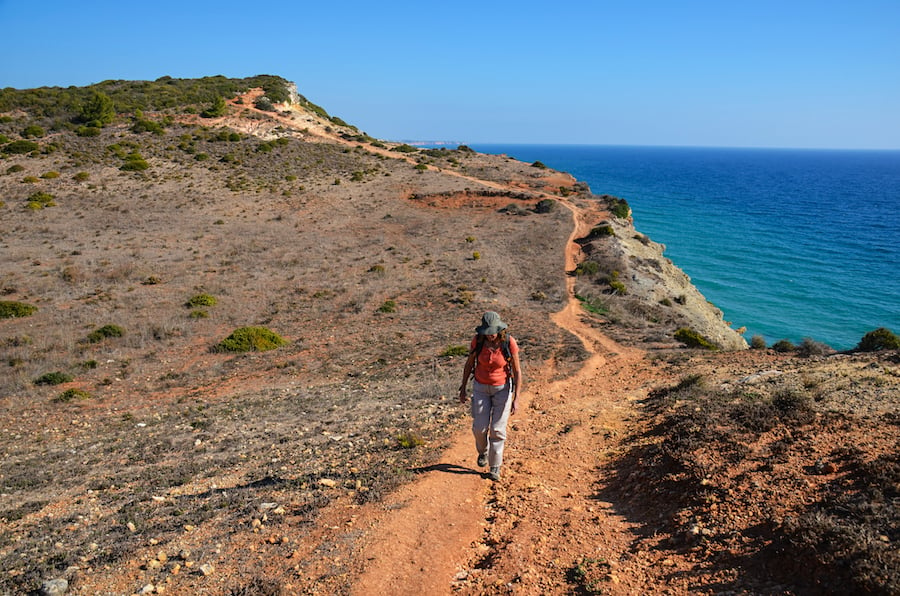Top walking holidays by the sea
It’s generally accepted walking is good for both body and mind; embracing nature offers an escape from the daily grind, allowing the thoughts to roam free.
Whilst many walking routes involve taking to the hills, there is something particularly exhilarating about following paths which meander along the coast. Sea air fills the lungs with an invigorating freshness; waves soothingly caress the sand or throw themselves rambunctiously against rocky shorelines, adding a soundtrack which can be either Vivaldi or Wagner. On the warmest days a gentle ocean breeze cools the skin. Ahead, the path dips and curves, teasing its way to treasures as yet unknown. Combined, these features can make the heart soar as high as seabirds riding the air currents above.
These are core ingredients which tend to come as standard with walking holidays by the sea. Slow travel specialists Inntravel’s self-guided walking holidays include these and far more. They are as much a voyage of discovery, where different locations reveal their own unique, scenic, historic and often quirky contributions to surprise and delight walkers.
Here are six seaside snapshots from a selection of Inntravel walking holidays around Europe as way of illustration.
Mythical walking on Crete
Leave sun-worshippers on the idyllic white sands at Crete’s Elafonisi Beach behind to head south and east. A littoral path passes numerous quiet coves and crosses dunes where the air is perfumed by wild thyme and shaggy goats balance on the gnarled limbs of juniper trees in attempts to reach the juiciest leaves of the upper branches. Where the scenery is of the jaw-dropping variety, the coastline is alive with remnants of the past. In one tranquil bay marble columns from the 3rd century A.D. litter the beach like discarded flotsam. In another, the ruins of an ancient city lie concealed within the confines of a natural cul-de-sac. Maybe best of all is a cave high on a hillside which, local legend has it, was once the home of Polyphemus, the one-eyed Cyclops who planned on feasting on Odysseus.

Catalan Coast
Volcanic landscapes on La Palma
One of Inntravel’s walking routes on the Canary Island of La Palma involves a truly unique experience. Part of the land it crosses didn’t exist until 1971 when the Teneguía Volcano blew its top, creating an ‘extension’ to the island’s coastline. Above the coast is the circular rim of Volcán San Antonio which added its own creative touch to the landscape when it erupted in 1677. This is a strangely beautiful world where camels were once used instead of horses to help repel pirate attacks, vines grow on black ash slopes, and paths wind around angry looking volcanic cones. It is an anarchic terrain which is also testament to human spirit and ingenuity. As well as the vines, banana plantations bring colour to the terrain and, at Las Salinas, glinting mini white mountains beside neat rectangular salt basins add an extra surreal touch to the scenery.
The Algarve’s golden wonders
Portugal’s shoreline boasts an envious amount of seemingly endless stretches of golden sand. If any list of ‘the best beaches in Europe’ doesn’t include at least one Portuguese praia then the author hasn’t done their homework. The Algarve is especially blessed with picture postcard beaches, many waiting to be discovered well away from the holiday resorts this area of Portugal is known for. One stunning section of coastline is found between Praia de Benagil and Praia da Marinha. The path hugs honey-coloured clifftops, traversing a series of vales suspensos (hanging valleys) and skirting enclosed bays lapped by crystalline water, arched sea caves, spindly stacks, and gaping sinkholes – all the work of Mother Nature at her creative best. It’s a walking route where just when you think views can’t get any better you turn a cistus-scented corner to be proved wrong.
Historic lookouts on Corsica
A water taxi deposits you on Plage du Lotu where there’s a temptation to get prone and stay put. As fellow passengers head to Plage de Saleccia, you veer in the opposite direction to follow a charmer of a coastal trail back to Saint-Florent, passing exquisite sandy coves in turquoise bays en route. These can only be reached from the sea or by putting in the leg work, so many remain sunbathers-free. This perfect coastline wasn’t always as calm as the sparkling Mediterranean keeping walkers’ company. A crumbling Genoese fortress harks back to a time when Corsica was regularly attacked by seafaring miscreants. In 1794 naval forces under the command of Admiral Nelson failed to capture the tower at Punta Mortella. The British were so impressed by its effectiveness at warding off assaults from the sea that over 100 similar structures were erected along England’s south coast.

Costa Brava
Fruits from the sea in Costa Brava
As well as wandering sun-kissed paths, Slow Travel of this sorts involves immersion in local gastronomy. Although all the locations mentioned have their own delicious delicacies, Costa Brava’s cuisine is especially renowned. It was home to El Bulli, maestro chef Ferran Adrià’s famous restaurant. Inland, at Girona, is El Cellar de Can Roca, regularly voted one of the best restaurants in the world. The tastiest food in Costa Brava isn’t only found in its Michelin star restaurants. As you walk through pine forests and skirt secluded bays between quaint fishing villages there’s plenty of opportunity to become acquainted with regional favourites. Prawns from Palamós, the town where Truman Capote wrote In Cold Blood, are sought after because of their succulent sweetness, whilst the fish restaurants at Tamariu, a serene beauty spot, are in a perfect location for tucking into the Catalan fish stew suquet de peix.
Sandy strolling on Isla de Lobos
Finally, a walk covering an entire coastline. This isn’t as daunting as it sounds. Isla de Lobos, fifteen minutes by boat from Fuerteventura, only covers four and a half square kilometres. In winter, the island’s residents consist of various birds and a couple of fishermen who can be seen trawling sea pools beside the stone huts of the islet’s only hamlet. A sandy path circumnavigates the coast, weaving through salt marshes and los hornitos (little ovens) – mini volcanic mounds formed after hot lava met water. At the halfway point is a lonely lighthouse whose elevated position gives expansive views back across this strange little world. The return route crosses salt pans before ending at a tranquil bay and a sculpted family of monk seals, the ‘lobos‘. Known as sea wolves, they once thrived here before post-conquest settlers wiped them out.
For more details visit Inntravel or telephone 01653 617 001




















